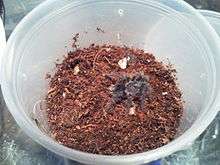Phormictopus cancerides
| Hispaniolan Giant Tarantula | |
|---|---|
| Scientific classification | |
| Kingdom: | Animalia |
| Phylum: | Arthropoda |
| Class: | Arachnida |
| Order: | Araneae |
| Suborder: | Mygalomorphae |
| Family: | Theraphosidae |
| Genus: | Phormictopus |
| Species: | P. cancerides |
| Binomial name | |
| Phormictopus cancerides (Latreille, 1806) | |
| Synonyms | |
|
Mygale cancerides | |
The Hispaniolan Giant Tarantula (Phormictopus cancerides) is a tarantula native to the Dominican Republic, where it is called Cacata; Haiti, where it is called Araignée-crab; and Cuba, where it is rare. It occurs from the West Indies to Brazil.[1] During the day they hide under rocks and debris and come out at night to look for prey. Their fangs are quite formidable at more than 2 centimeters long, and when they pierce the body of a victim, venom is injected which paralyzes and breaks down the body tissue of the prey, allowing the tarantula to suck up the liquified insides. Its bite is not harmful to humans but can cause irritation and swelling.

Their most dangerous predator is the pepsis wasp, commonly called the Tarantula hawk. Locally it is known as a Matacacata (The Tarantula-killer). This is a very large wasp, with an iridescent blue-green body and orange-red wings that grows to about 2 inches or more in length. It captures the spider in its burrow or sometimes in the open and stings it to paralyze it and then lays its eggs on the abdomen. The wasp will drag its victim to a safe place to incubate its young. Once the larvae hatch they will feed on the alive but paralyzed tarantula until it dies.
Despite the fact it can defend itself by biting or more commonly by kicking the urticating hairs from its abdomen, the spider's color makes it an attractive pet. They can be kept easily in a terrarium that measures at least four times its leg span in length. The terrarium should be furnished with a substrate, a water dish and a hiding place, otherwise they will dig a burrow. They should be kept at temperatures of between 22 and 28 °C which can even decrease under 20 °C in the night which is uncommon in tropical tarantulas – the difference between temperature during the day and the night is important if one wants to breed this species (Kovařík, 2001), and a diet of four to six crickets every two weeks.
Subspecies, NO LONGER VALID
- Phormictopus cancerides cancerides (Latreille, 1806)—Haiti
- Phormictopus cancerides centumfocensis (Franganillo, 1926)—Cuba
- Phormictopus cancerides tenuispina Strand 1906—South America
Footnotes
- ↑ Platnick, 2008
References
| Wikimedia Commons has media related to Phormictopus cancerides. |
| Wikimedia Commons has media related to Phormictopus cancerides cancerides. |
- Kovařík, František (2001): Chov sklípkanů (Keeping tarantulas), Jihlava. ISBN 80-86068-29-3
- Platnick, Norman I. (2008): The world spider catalog, version 8.5. American Museum of Natural History.